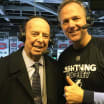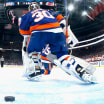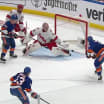The New Jersey Devils will honor Martin Brodeur by unveiling a statue in his honor outside Prudential Center on Feb. 8 and retiring his No. 30 prior to a game against the Edmonton Oilers on Feb. 9. NHL.com is honoring Brodeur by taking a look back at his record-breaking and likely Hall of Fame career in a series of stories counting down to his jersey retirement ceremony.
Here is the story of Brodeur's goal in the 1997 Stanley Cup Playoffs:
Former New Jersey Devils forward John MacLean was cutting across the red line, stick out, waiting for one of Martin Brodeur's tape-to-tape passes to come his way late in Game 1 of the Eastern Conference Quarterfinals against the Montreal Canadiens on April 17, 1997.
'Everything was right on that play'
Brodeur will never forget scoring goal in 1997 playoffs
The puck came, all right, but not on the ice, not to MacLean's stick. It was in the air, not out of MacLean's reach but high enough to where he'd have to bring it down with his glove instead of his stick.
"I was close, very close," MacLean said.
Imagine if he did knock it down. Imagine if he didn't realize what Brodeur was going for in the final minute of New Jersey's 5-2 win. He'd have been known as the player who stole Brodeur's Stanley Cup Playoff goal against his childhood team.
No, MacLean couldn't. He didn't.
"I had an idea for what he was doing," MacLean said.
And Brodeur did it, sending the puck soaring through the air and bounding into the net, only seconds earlier vacated by Jocelyn Thibault, to become the second goalie in NHL history to score a goal in the playoffs. Ron Hextall did it on April 11, 1989.
"To do it against Montreal on top of it, with all my buddies watching and getting mad at me, made it even better," Brodeur said. "You know what? I had tons of chances when I played junior and I couldn't get it done. I took a lot of pride in being active, playing the puck, but physically to score a goal, everything was right on that play."
Brodeur can still diagram it.
"Dave Manson probably had the worst dump-in a guy could have done on a goalie that could play the puck," Brodeur said. "It put me on a tee, almost. I turned around, everybody got out of the way, we had a two-goal lead at the time and I'm like, 'You know what? Let's go for it.' I went down on one knee to make sure I was getting as much as possible of the puck. I was able to raise it to the red line. It went over a few guys. Johnny Mac, I'm surprised he didn't touch it. He knew I was shooting it."
Doug Gilmour went to dig the puck out of the net before coming down the ice to congratulate Brodeur.
"I didn't have one goal that [playoffs]," Gilmour said, laughing. "He outscored me, but I had more assists."
Gilmour was in his 14th NHL season. It was the first time he had seen a goalie shoot the puck down the ice to score a goal on a shot on goal. It has happened only seven times in NHL history.
Brodeur was credited with two more goals in his career, but the playoff goal was the only time he shot the puck into the net himself.
"There is a picture showing me with my big smile and jumping up in the air after the goal, and if you look right above my shoulder you see my brother [Denis] and my son Anthony in his hands," Brodeur said. "That picture, I love it. I had season tickets back then in the third row behind my blocker. That's pretty cool."
Former Devils goalie Chris Terreri remembers watching Brodeur score the goal on television. He was elated, but not surprised.
"You knew it was only a matter of time," Terreri said.
That was the feeling around the Devils when Brodeur first broke in for good in 1993-94. His ability to play the puck was top notch, as good as Hextall, some might even say better.
Former Devils goalie coach Jacques Caron said Brodeur's stick handling came from playing forward before he learned how to be a goalie.
"And he's got terrific hands," Caron said. "He's also a great golfer. His hand-eye coordination is good and he had confidence that he could do something if he went out of his net. It wasn't just to get the puck away from the boards. He loved handling the puck. It made him different."
It also changed the way the Devils played. Brodeur could be a third defensemen until the NHL put in the trapezoid behind the net to restrict goaltenders from going into the corners.
"Why do you think I was up there at the red line?" MacLean said. "It was because of how he handled the puck. It was like, 'Oh, Marty's got it, take off.' There was always a chance he would fire it or make a tape-to-tape pass. Even if there was a goalie in the net you would do it because you knew you might get a breakaway pass. Not many goalies could do that."

















